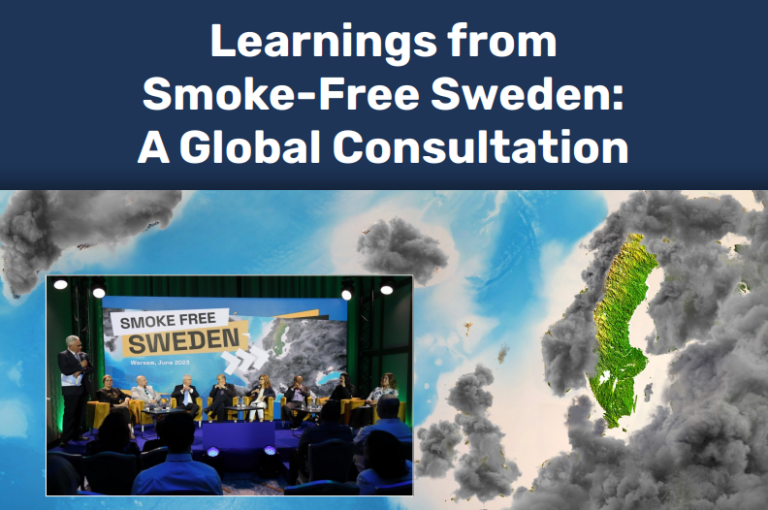Over the past six months, Smoke Free Sweden has visited four continents and engaged with dozens of international public health experts.
Its resulting report, entitled “Learnings from Smoke-Free Sweden. A Global Consultation”, offers seven distinct and straightforward recommendations for reducing smoking rates to become smoke-free, as Sweden is on the brink of doing.
Sweden’s success in becoming smoke-free lies in its approach of making smokeless alternatives to cigarettes available, acceptable, and affordable.
Just 5.6% of Swedes smoke, only slightly above the official ‘smoke-free’ threshold of 5%, and as a result, the country benefits from the lowest rate of tobacco-related death and disease in the EU.
Commenting on the report, Smoke Free Sweden leader Dr Delon Human said: “We journeyed to Warsaw, Dhaka, Johannesburg, Stockholm, and São Paulo. From our discussions, we identified a consensus among international experts. Four foundational pillars of the Swedish experience stand out and are recommended for global adoption: embracing harm reduction strategies, ensuring accurate risk communication, providing access to reduced-risk nicotine products, and promoting consumer acceptance of smoke-free products.”
The report’s fifteen signatories, drawn from New Zealand to Colombia, hope that the World Health Organization, which has so far been resistant to embracing less harmful alternatives, will take heed of the report’s recommendations and recognise how tobacco harm reduction can play a role in improving the lives of the world’s 1 billion remaining smokers.
Complementing their efforts, the campaign has released a video that captures the global endorsement for the Swedish model, showcasing events, media interactions, and comments from policymakers.
What the world should know about Sweden: recommendations for policymaker
The upcoming COP meeting, as well as the revision of the EU’s Tobacco Products Directive (TPD), provide an opportunity to policymakers to fully examine the life-saving impact of the Swedish approach. WHO data shows clearly that Sweden’s incidence of cancer is 41% lower than the rest of its European counterparts, corresponding to a 38% lower level of total cancer deaths. Sweden has a 39.6% lower rate of death of all tobacco-related diseases compared to the EU average. As a result of our ongoing research and collaboration with renowned experts from around the globe, we call on governments to take into consideration the Swedish case study and we propose propose a series of policy solutions to be taken into account by policymakers:
Harm reduction: Develop and embrace harm reduction strategies.
Implement risk-appropriate nicotine regulation: The Swedish model has proven to be a highly effective approach to tobacco control, leading to significantly reduced smoking rates and associated health issues.
Understand the life-saving benefits of the Smoke-Free Sweden model: Our research paper, Saving Lives Like Sweden, found that if every EU country followed Sweden’s approach and made safer alternatives affordable, acceptable and accessible to smokers, just under 3 million European lives could have been saved between 2000 and 2019.
Promote the Swedish experience globally: Encourage the widespread adoption of the Swedish model in other regions, highlighting its success in reducing smoking prevalence and the associated health risks, and promote the Swedish Experience at global fora such as the FCTC COP. This will contribute to the global efforts to reduce the harm caused by tobacco use.
Focus on quitting, or at least switching to smoke-free alternatives underpinned by clear information on relative risks: Our experts have emphasised the unequivocal potential benefits of utilising alternative nicotine products as a harm reduction strategy. The WHO must take note, and commission official research into what has made Sweden smoke-free 17 years ahead of the EU target.
Implement accurate risk communication: Policymakers at national, regional and global level should ensure that regulations make distinct risk-based differentiations between combustible and non-combustible nicotine products, so they cannot be treated equally. This approach will facilitate more accurate risk communication to consumers, enabling informed decision-making.
Accessibility, Affordability and Acceptability: Governments should pursue policies that will allow smoke-free products to be accessible, acceptable and affordable. Policymakers should consider implementing policies that would allow these products to become more accessible and acceptable to smokers, including the use of regulated flavours.

CONTACTS
Republic of Kazakhstan, 050010, Astana City,
Kabanbay batyr str. 34/1
+7 727 331 89 98
info@qazspirits.com
© 2015-2023. All rights reserved.